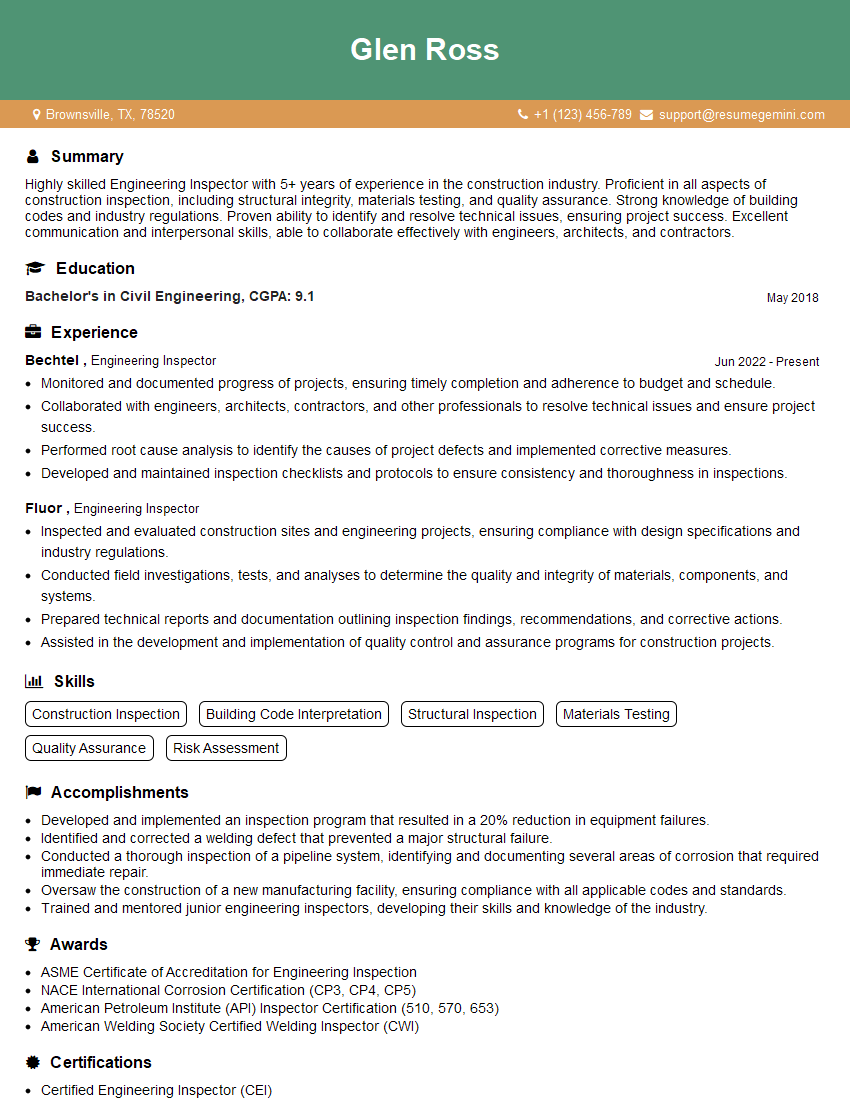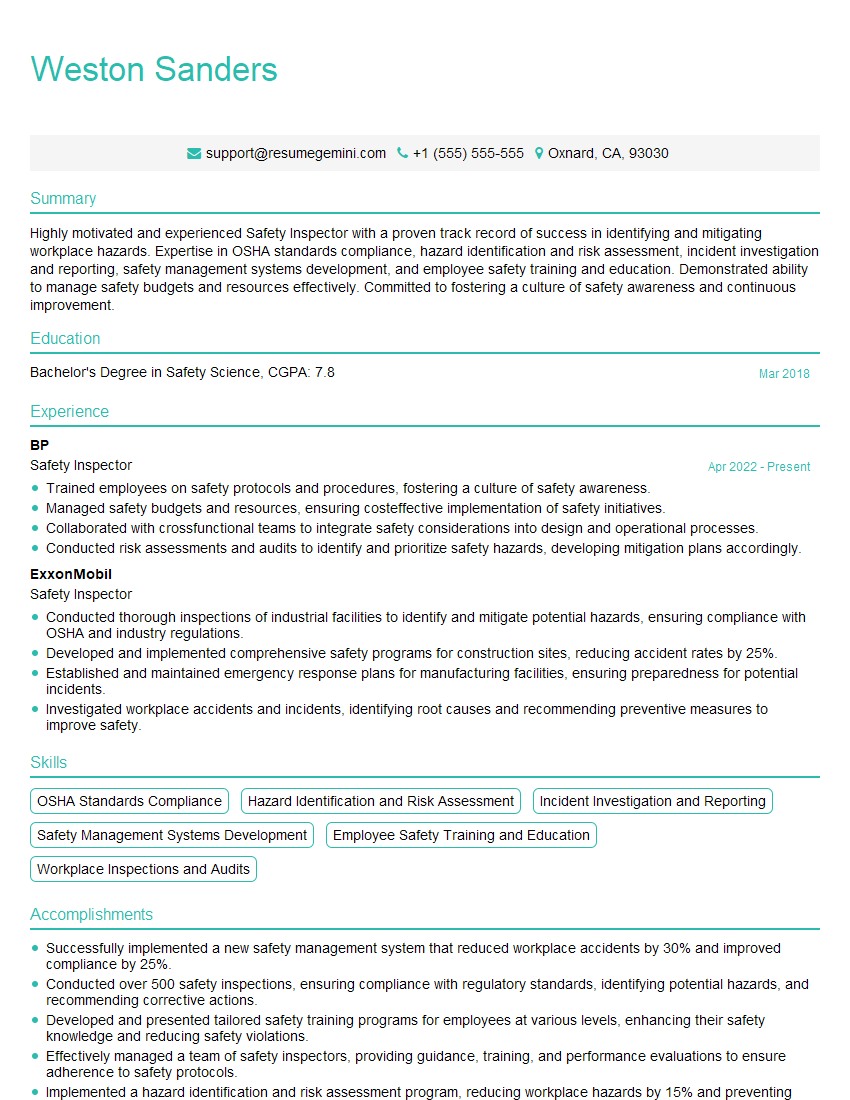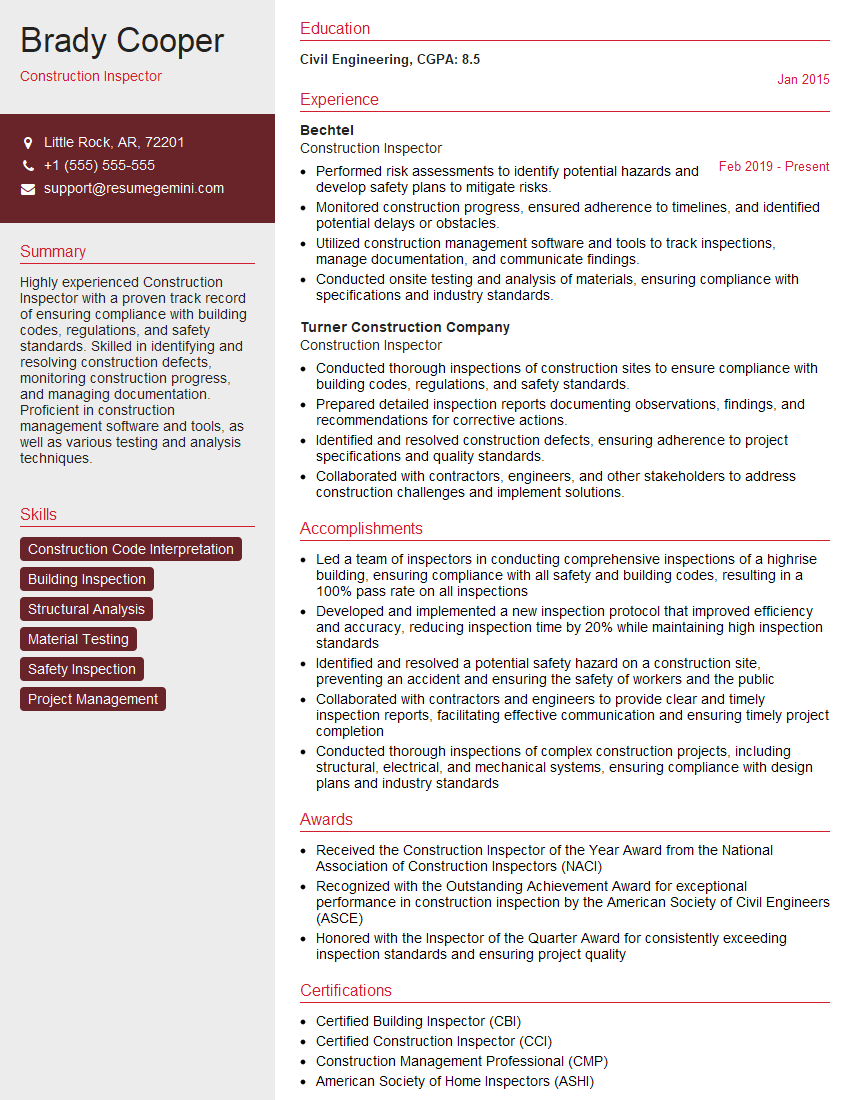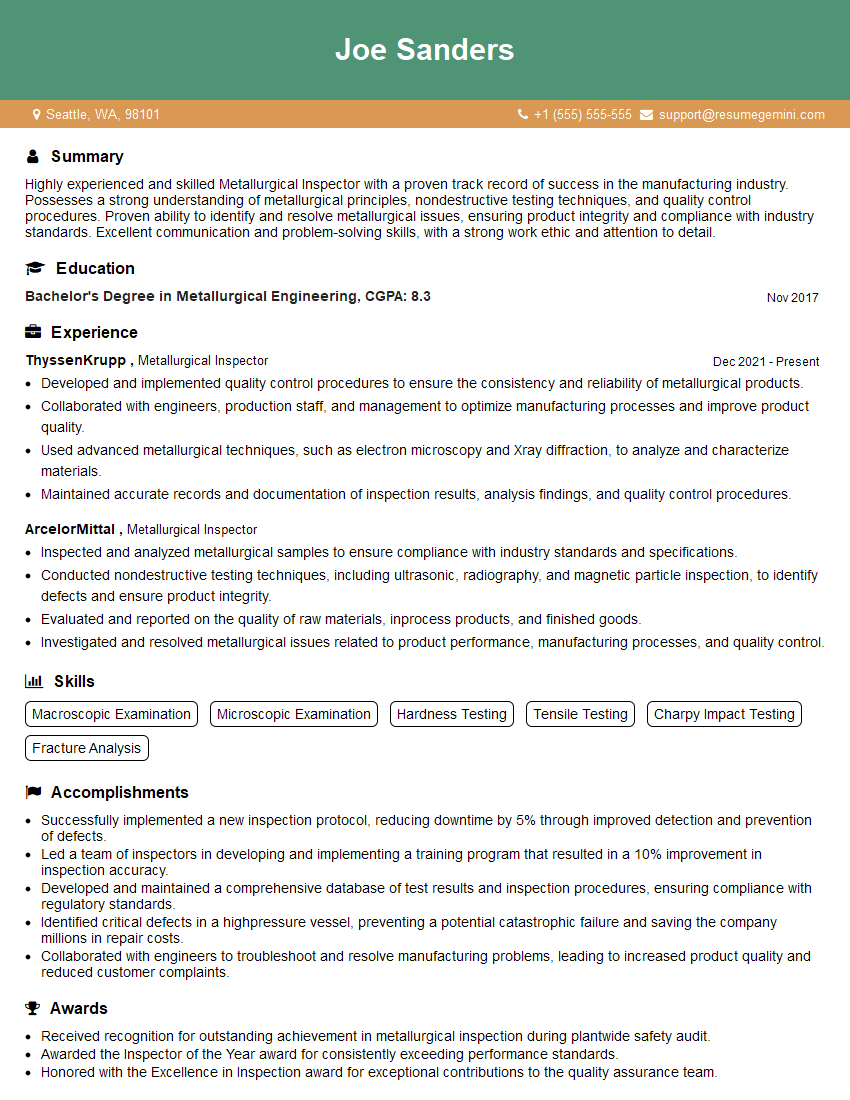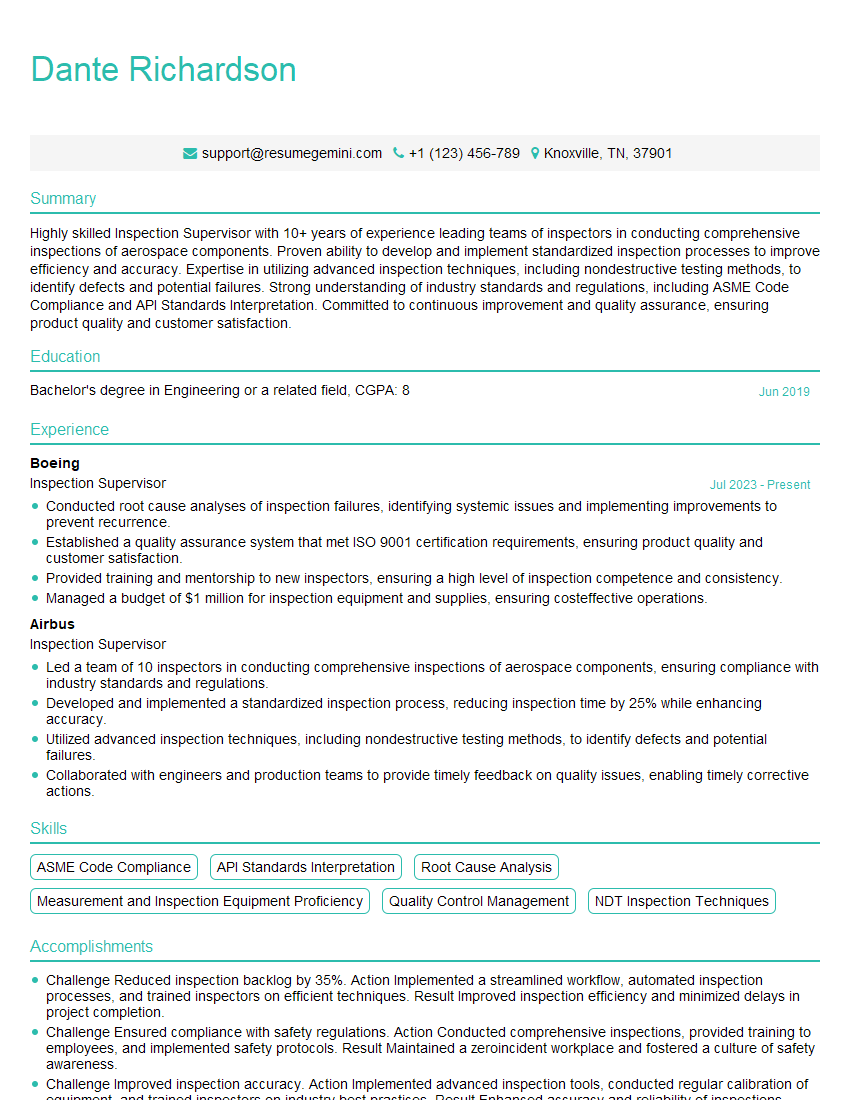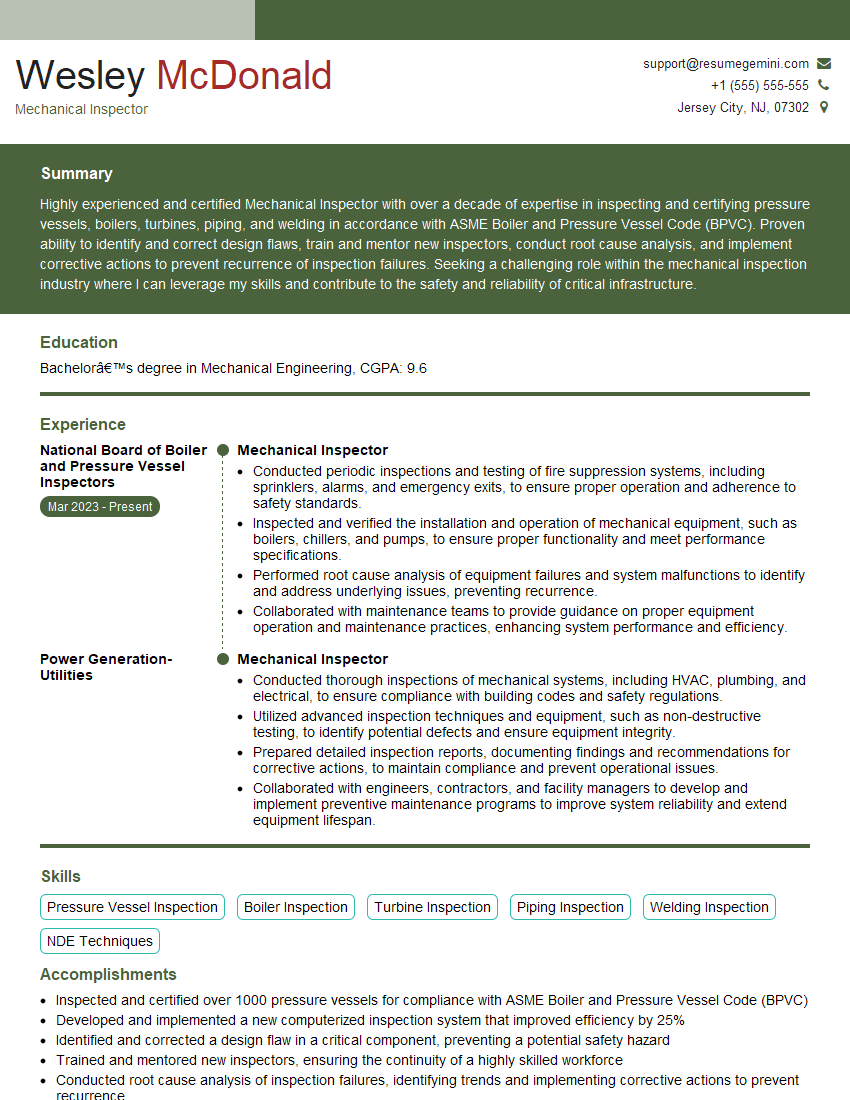Feeling uncertain about what to expect in your upcoming interview? We’ve got you covered! This blog highlights the most important Wire rope coupling inspection interview questions and provides actionable advice to help you stand out as the ideal candidate. Let’s pave the way for your success.
Questions Asked in Wire rope coupling inspection Interview
Q 1. What are the common types of wire rope couplings?
Wire rope couplings are crucial components connecting wire rope sections, ensuring continuous transmission of force. Several types exist, each designed for specific applications and rope diameters. Common types include:
- Mechanical Couplings: These utilize mechanical means to clamp the rope ends together. Examples include compression couplings (using wedges or sleeves to squeeze the rope), and various types of clamps (like U-bolt clamps).
- Spliced Couplings: These involve skillfully interweaving the strands of the rope ends to create a continuous length. This requires specialized expertise and is often used when high strength and smooth operation are paramount.
- Socket Couplings: These are typically used with wire ropes equipped with end sockets. The sockets are then connected via a threaded fitting or a swaged connection, creating a strong and reliable joint.
The choice of coupling depends on factors such as rope diameter, load requirements, working environment, and ease of installation.
Q 2. Explain the different methods for inspecting wire rope couplings.
Inspecting wire rope couplings requires a multi-faceted approach, combining visual inspection with potentially more advanced methods:
- Visual Inspection: This is the most common and crucial first step. It involves carefully examining the coupling for signs of damage or wear (detailed in the next answer).
- Dimensional Checks: Using measuring tools, verify that the coupling components are correctly aligned and have not experienced significant deformation or misalignment.
- Non-Destructive Testing (NDT): For critical applications, methods like ultrasonic testing or magnetic particle inspection may be used to detect internal flaws within the coupling’s material or rope structure.
- Load Testing: In controlled environments, destructive or non-destructive load testing can assess the coupling’s residual strength and verify its load-carrying capacity.
The method selected depends on the criticality of the application and available resources. A visual inspection is usually mandated, with additional checks as needed.
Q 3. Describe the visual inspection criteria for wire rope couplings.
Visual inspection is paramount for wire rope coupling safety. Inspectors look for:
- Corrosion: Look for rust, pitting, or any signs of chemical degradation on the coupling and the wire rope ends.
- Damage to Clamps or Sleeves: Check for cracks, bends, or deformation in compression sleeves or U-bolt clamps. Ensure proper tightness and alignment.
- Wire Rope Condition: Assess the condition of the wire rope near the coupling. Look for broken wires, significant wear, or kinks. The rope must be securely seated within the coupling.
- Wear and Abrasion: Look for areas of excessive wear or abrasion on the coupling surfaces, especially where metal-to-metal contact occurs.
- Misalignment: Verify the coupling is properly aligned with the wire rope sections. Misalignment indicates potential stress concentration and premature failure.
Remember, documenting the inspection with photos and a detailed report is essential for record-keeping and future reference.
Q 4. What are the signs of a damaged or worn wire rope coupling?
Several indicators signal a damaged or worn wire rope coupling:
- Visible Cracks or Breaks: In the coupling components themselves (clamps, sleeves, or socket bodies).
- Excessive Wear or Deformation: Significant wear on the clamping surfaces or deformation of the coupling components beyond acceptable limits.
- Loose Fittings: If bolts or nuts are loose, it indicates insufficient clamping force and potential slippage.
- Rope Strands protruding: Strands of the wire rope protruding from the coupling suggest that the clamping pressure is inadequate.
- Unusual Noises or Vibrations: During operation, unusual sounds or vibrations from the coupling area suggest internal problems or looseness.
If any of these signs are present, the coupling should be immediately replaced. Continued use poses significant safety risks.
Q 5. How do you assess the strength of a wire rope coupling?
Directly assessing the strength of a wire rope coupling in the field is challenging. However, the following can help determine its suitability:
- Visual Inspection and Condition Assessment: A thorough visual check helps to identify potential weaknesses or damage that may compromise strength.
- Manufacturer’s Specifications: Refer to the manufacturer’s specifications for the coupling’s rated capacity. This must always be lower than the breaking strength of the wire rope itself.
- Comparison with New Couplings: Comparing the coupling’s condition to a new, similar coupling helps to determine the level of wear and potential strength reduction.
- Load Testing (Specialized Environment): For critical applications, load testing under controlled conditions can determine the remaining strength, but this is often destructive.
Remember, it’s safer to replace a coupling that shows signs of significant wear or damage than to risk a catastrophic failure.
Q 6. What are the safety regulations and standards relevant to wire rope coupling inspection?
Safety regulations and standards concerning wire rope coupling inspection vary by jurisdiction but often align with international standards like those from organizations such as ISO and ANSI/ASME. These standards outline requirements for the design, manufacture, installation, and inspection of wire rope and associated fittings. Key aspects include:
- Regular Inspection Frequency: Standards dictate how often inspections should be performed based on factors such as the application’s severity, environmental conditions, and the coupling’s type.
- Documentation Requirements: Detailed inspection records must be maintained, including the date, findings, and any corrective actions taken.
- Acceptance Criteria: Standards specify acceptable limits for wear, corrosion, and damage, guiding decisions on coupling replacement or repair.
- Competency of Inspectors: Trained and qualified personnel should conduct inspections, ensuring consistent application of standards and accurate assessments.
Failure to comply with relevant regulations can lead to severe penalties and potentially catastrophic accidents.
Q 7. How do you determine the correct type of wire rope coupling for a specific application?
Choosing the right wire rope coupling demands careful consideration of several factors:
- Wire Rope Diameter and Construction: The coupling must be compatible with the wire rope’s diameter, construction type (e.g., 6×19, 6×36), and material.
- Load Requirements: The coupling’s rated working load limit (WLL) must exceed the anticipated load on the wire rope system. Safety factors are always incorporated.
- Environmental Conditions: Consider corrosion resistance if the coupling will be exposed to harsh environments (e.g., saltwater, chemicals).
- Ease of Installation and Maintenance: Some couplings are easier to install and maintain than others. This is crucial depending on the application and accessibility.
- Budgetary Constraints: Different coupling types have varying costs. A balance must be struck between cost and performance.
Always consult relevant standards and manufacturer’s specifications to ensure compatibility and safe operation. When in doubt, seek guidance from a qualified rigging engineer.
Q 8. What is the importance of regular wire rope coupling inspection?
Regular inspection of wire rope couplings is paramount for ensuring operational safety and preventing catastrophic failures. Think of it like a regular checkup for your car – you wouldn’t drive across the country without making sure your brakes and tires are in good condition, right? Similarly, neglecting wire rope coupling inspection puts lives and equipment at risk. These couplings are critical components in many heavy-duty applications, transferring significant loads. Regular inspections allow for early detection of wear, corrosion, or damage, enabling timely repairs or replacements, thus preventing unexpected downtime and costly repairs.
Regular inspections help identify issues like:
- Wire rope damage: Broken wires, corrosion, or abrasion can significantly reduce the rope’s strength.
- Coupling component wear: Worn sockets, damaged clamps, or loose fasteners can lead to slippage or complete failure.
- Improper installation: Incorrect installation can compromise the coupling’s integrity and load-bearing capacity.
Q 9. What are the consequences of failing to inspect wire rope couplings properly?
Failing to properly inspect wire rope couplings can have severe consequences, ranging from minor inconveniences to catastrophic events. Imagine a crane lifting a heavy load – a failure of the wire rope coupling could result in the load dropping, potentially causing injury or damage. The consequences can include:
- Equipment damage: A failed coupling can lead to damage to the equipment being used, resulting in costly repairs or replacements. This could be anything from a broken lifting mechanism on a crane to a damaged conveyor belt system.
- Injury or fatality: In situations involving heavy lifting or transportation, coupling failure can lead to serious injury or even death to personnel nearby.
- Production downtime: Unexpected failures cause significant production delays and lost revenue, especially in industries relying on continuous operations.
- Environmental damage: Depending on the application, a coupling failure could lead to environmental damage, for example, in mining or offshore operations.
- Legal repercussions: Failure to maintain equipment properly can lead to legal liability and financial penalties.
Q 10. Describe the process for documenting inspection findings.
Documenting inspection findings is crucial for maintaining a comprehensive record of the coupling’s condition over time. This documentation serves as a valuable tool for tracking wear and tear, predicting potential failures, and ensuring compliance with safety regulations. A well-structured inspection report should include:
- Date and time of inspection: This ensures accurate record-keeping and traceability.
- Inspector’s name and qualifications: Provides accountability and verifies the inspector’s competence.
- Coupling identification number or location: Allows for easy identification of the specific coupling inspected.
- Detailed description of the coupling’s condition: Include observations on wear, corrosion, damage, and any other abnormalities detected. Use clear and concise language.
- Photographs or sketches: Visual aids provide additional context and clarify any written observations.
- Recommended actions: Outline any necessary repairs, replacements, or further inspections.
- Inspector’s signature: Confirms the accuracy and authenticity of the report.
The report should be stored securely and easily accessible for future reference. A digital system is often preferable, allowing for easy search and retrieval of past inspection data.
Q 11. Explain how to use non-destructive testing methods in wire rope coupling inspection (if applicable).
While visual inspection is the primary method, non-destructive testing (NDT) methods can be employed for a more in-depth assessment, especially in critical applications or when visual inspection reveals potential problems. Common NDT methods include:
- Magnetic Particle Inspection (MPI): Detects surface and near-surface cracks in ferromagnetic materials. This is useful for identifying cracks in the coupling’s metal components.
- Ultrasonic Testing (UT): Uses high-frequency sound waves to detect internal flaws and measure the thickness of materials. This can be used to assess the integrity of the wire rope itself and the coupling components.
- Dye Penetrant Inspection (DPI): Detects surface-breaking flaws by drawing a dye into the cracks, which are then made visible by a developer. Helpful in identifying surface cracks or flaws in the coupling.
The selection of the appropriate NDT method depends on the specific type of coupling and the potential failure modes being investigated. It’s important to have trained personnel perform these tests to ensure accurate results and interpretation. Interpreting NDT results often requires specialized knowledge and experience.
Q 12. How do you handle a situation where a wire rope coupling fails inspection?
If a wire rope coupling fails inspection, immediate action is required. The coupling should be immediately taken out of service to prevent any potential accidents. The steps to follow include:
- Isolate the affected area: Restrict access to the area to prevent accidental injury or damage.
- Document the failure: Thoroughly document the reason for the failure, noting specific damage or deficiencies observed.
- Implement corrective actions: This could involve repairing the coupling, replacing it entirely, or modifying the system to prevent future failures. The decision depends on the severity of the damage and the feasibility of repair.
- Communicate findings: Inform relevant personnel, including supervisors, engineers, and safety officers, about the failure and corrective actions taken.
- Investigate root cause: Conduct a thorough investigation to determine the root cause of the failure and prevent similar incidents from occurring in the future.
The process may involve engaging specialists in wire rope technology to diagnose the problem and recommend the appropriate solution. It’s crucial to prioritize safety during this entire process.
Q 13. What are the limitations of visual inspection for wire rope couplings?
Visual inspection, while a crucial first step, has limitations in detecting all potential problems with wire rope couplings. It’s primarily effective at identifying surface-level issues like: visible damage, corrosion, or loose fasteners. However, it cannot readily detect:
- Internal flaws: Internal corrosion or broken wires within the wire rope are difficult, if not impossible, to detect by visual inspection alone.
- Fatigue cracking: Microscopic fatigue cracks might not be visible to the naked eye, even with magnification.
- Hidden damage: Damage hidden beneath coatings or encasements may not be visible.
Therefore, visual inspection should be supplemented with other methods, particularly in high-risk applications, to provide a more comprehensive assessment. This could include hands-on examination combined with NDT as described previously. Remember that visual inspection is an important part of a complete inspection program, not the whole program.
Q 14. How do environmental factors affect wire rope coupling lifespan?
Environmental factors significantly impact the lifespan and integrity of wire rope couplings. Exposure to harsh conditions accelerates wear and tear, leading to premature failure. Key factors include:
- Corrosion: Exposure to moisture, saltwater, or chemicals accelerates corrosion, weakening the wire rope and coupling components. This is especially problematic in marine environments or industrial settings with corrosive chemicals.
- Temperature extremes: Extreme temperatures (both high and low) can affect the material properties of the wire rope and coupling, leading to embrittlement or weakening.
- UV radiation: Prolonged exposure to ultraviolet (UV) radiation can degrade the wire rope’s polymer coatings, making it more susceptible to damage.
- Abrasion: Contact with other materials or surfaces can cause abrasion and wear, reducing the wire rope’s diameter and strength.
Understanding these environmental factors is essential for selecting appropriate materials and implementing preventative measures. This might include using corrosion-resistant materials, applying protective coatings, and implementing regular cleaning and lubrication schedules.
Q 15. Explain the difference between different types of wire rope constructions.
Wire rope construction refers to how individual wires and strands are arranged to form the final rope. Different constructions offer varying strength, flexibility, and resistance to wear. The most common types are:
- 6×7 (Six strands of seven wires each): This is a relatively inexpensive and flexible construction, often used in applications where flexibility is prioritized over ultimate strength. Think of it like a thinner, more flexible cable.
- 6×19 (Six strands of nineteen wires each): This offers a better balance of strength and flexibility compared to 6×7. It’s a popular choice for many general-purpose applications, providing a good compromise between strength and ease of handling. It’s a bit like a stronger, more versatile rope.
- 6×37 (Six strands of thirty-seven wires each): This construction provides superior strength and fatigue resistance, but it is less flexible than 6×7 or 6×19. It’s ideal for applications demanding high tensile strength and durability, making it suitable for heavy lifting or demanding industrial tasks. Think of it as a thick, very strong cable.
- 8×19 (Eight strands of nineteen wires each): Similar to 6×19 in terms of strength and flexibility, but with improved resistance to crushing. Often selected where the rope may be subject to lateral forces.
The choice of construction depends entirely on the specific application and the priorities of strength, flexibility, and cost. Incorrect selection can lead to premature failure.
Career Expert Tips:
- Ace those interviews! Prepare effectively by reviewing the Top 50 Most Common Interview Questions on ResumeGemini.
- Navigate your job search with confidence! Explore a wide range of Career Tips on ResumeGemini. Learn about common challenges and recommendations to overcome them.
- Craft the perfect resume! Master the Art of Resume Writing with ResumeGemini’s guide. Showcase your unique qualifications and achievements effectively.
- Don’t miss out on holiday savings! Build your dream resume with ResumeGemini’s ATS optimized templates.
Q 16. What is the purpose of lubrication in wire rope maintenance?
Lubrication is crucial for wire rope maintenance, extending its lifespan and preventing premature failure. It serves several key purposes:
- Reduces Friction: Lubricant minimizes friction between individual wires and strands, reducing wear and tear. This is akin to oiling a bicycle chain—it keeps the components moving smoothly.
- Protects Against Corrosion: Lubricants act as a barrier against moisture and other corrosive elements, preventing rust and degradation of the wires. Think of it as applying sunscreen to your skin—it protects from damaging UV rays.
- Prevents Internal Wire Breakage: Proper lubrication reduces internal friction, preventing the individual wires from breaking under stress. This means your rope won’t start fraying or breaking unexpectedly.
- Improves Flexibility: Lubrication enhances the flexibility of the wire rope, making it easier to handle and reducing stress concentrations.
Regular lubrication is a cost-effective preventive measure, significantly reducing the risk of expensive repairs or replacements.
Q 17. Describe the proper techniques for handling and storing wire rope couplings.
Proper handling and storage are vital for maintaining the integrity of wire rope couplings. Follow these steps:
- Avoid Sharp Bends: Never bend the coupling or wire rope sharply, as this can cause significant damage and stress concentrations. Think of bending a paperclip too far—it breaks!
- Proper Lifting Techniques: When handling heavy couplings, always use appropriate lifting equipment and techniques to prevent damage or injury.
- Clean Storage Area: Store couplings in a clean, dry place, away from moisture, chemicals, and extreme temperatures. Moisture leads to corrosion and reduces the rope’s lifespan.
- Protection from Impact: Protect the couplings from impact damage during transportation and storage. Use protective packaging or covers to prevent scratches or dents that may weaken the coupling.
- Proper Organization: Arrange couplings in an organized fashion to prevent damage from stacking or tumbling.
Neglecting these precautions can lead to compromised coupling integrity, resulting in potential failures and safety hazards.
Q 18. How do you interpret wire rope coupling manufacturer specifications?
Manufacturer specifications are critical for safe and effective use of wire rope couplings. They provide essential information such as:
- Working Load Limit (WLL): This is the maximum load the coupling can safely handle. Never exceed the WLL.
- Material Specifications: This details the type of steel or other materials used in the coupling construction, influencing its strength and durability.
- Recommended Rope Diameters: The manufacturer specifies the appropriate wire rope diameters that can be used with the coupling to ensure proper fit and strength. Using the wrong rope diameter compromises the coupling’s efficacy.
- Installation Instructions: These instructions are critical for proper installation to ensure the coupling’s effectiveness and safety.
- Inspection Procedures: The manufacturer may outline recommended inspection and maintenance procedures to help prevent premature failure. Adhering to these recommendations is key to safety.
Always carefully review and adhere to manufacturer specifications. Deviation from these guidelines can compromise safety and lead to catastrophic failure.
Q 19. What are the common causes of wire rope coupling failure?
Wire rope coupling failures can stem from various causes:
- Overloading: Exceeding the Working Load Limit (WLL) is a primary cause of failure. The coupling is simply not designed to withstand loads beyond its capacity.
- Improper Installation: Incorrect installation, such as improper tightening or misalignment, can lead to stress concentrations and premature failure.
- Corrosion: Exposure to moisture and corrosive elements can weaken the coupling, making it prone to failure.
- Fatigue: Repeated cycles of loading and unloading can lead to metal fatigue, eventually causing failure.
- Impact Damage: External impacts can damage the coupling, reducing its strength and reliability.
- Wear and Tear: General wear and tear from continuous use will eventually weaken the coupling. Regular inspections are vital.
Regular inspection and preventative maintenance are crucial to identifying and addressing potential issues before they lead to failure.
Q 20. How do you identify and mitigate risks associated with wire rope couplings?
Risk mitigation involves a multi-pronged approach:
- Regular Inspections: Regular visual inspections, following manufacturer recommendations, are crucial to identify wear, corrosion, or damage before they become critical. Think of it as a regular checkup for your car.
- Proper Maintenance: This includes lubrication to prevent corrosion and reduce wear and tear, and replacement of worn or damaged components.
- Training: Proper training for personnel handling and inspecting wire rope couplings ensures safe practices and reduces the likelihood of errors.
- Load Monitoring: Using load monitoring devices can help prevent overloading and ensure that the coupling is not subjected to excessive stress.
- Documentation: Maintaining records of inspections, maintenance, and repairs allows for tracking of the coupling’s condition and identifying patterns that could indicate potential problems.
A proactive approach to inspection and maintenance, combined with proper training, dramatically reduces risks associated with wire rope couplings.
Q 21. What are the different types of wire rope end terminations?
Several methods exist for terminating wire ropes, each with its strengths and weaknesses:
- Swaged Terminals: These involve mechanically crimping a fitting onto the rope’s end, providing a strong and reliable termination. They’re like a permanent clamp.
- Wire Rope Clips (U-Bolts): These are used for temporary or less demanding applications. They’re cheaper but require careful placement to prevent rope damage.
- Socket Terminals: The rope is inserted into a socket and secured by molten metal (typically zinc) poured into the socket, providing a robust and long-lasting termination. Similar to Swaged Terminals but often more durable for very high loads.
- Spliced Terminations: This involves interweaving the strands of the rope to form a loop or eye. This is highly skilled work, often done by specialized technicians. It’s a more labor-intensive approach that requires expertise.
The selection of the appropriate termination method depends on the application, required strength, and budget constraints.
Q 22. Explain the significance of load ratings for wire rope couplings.
Load ratings for wire rope couplings are absolutely critical because they represent the maximum safe working load (SWL) the coupling can handle. Think of it like the weight limit on a bridge – exceeding it can lead to catastrophic failure. These ratings are determined through rigorous testing and are specified by the manufacturer. They take into account factors like the type of wire rope used, the coupling’s design, and the material’s strength. Ignoring or exceeding the load rating puts the entire system, and potentially personnel and equipment, at significant risk. For example, a coupling rated for 10 tons should never be used with a load exceeding that limit, even if it appears to be holding up under a slightly higher load. The safety margin is built into the rating, accounting for unforeseen stresses and potential material degradation.
Q 23. How do you ensure the accuracy and reliability of your inspection reports?
Accuracy and reliability in my inspection reports are paramount. I ensure this through a multi-faceted approach. First, I meticulously follow a standardized inspection checklist, documenting every step and finding. Second, I use calibrated and regularly maintained inspection equipment to obtain precise measurements. Third, all observations are recorded with clear, concise, and objective language, avoiding subjective terms. I use photographs and sketches to support my findings. Finally, I always double-check my work before submitting the report, and I’m happy to answer any clarifying questions the client may have. Maintaining a detailed audit trail of my inspections and calibrations further assures the validity of my findings. I consider accuracy and reliability not merely as professional standards, but as ethical obligations.
Q 24. What are some common mistakes to avoid during wire rope coupling inspection?
Several common mistakes can compromise the safety and accuracy of wire rope coupling inspections. One is failing to check for proper lubrication. Insufficient lubrication can lead to premature wear and breakage. Another is overlooking corrosion, which significantly weakens the rope and coupling. Failing to inspect the clamping mechanism thoroughly is also a critical error; loose clamps can lead to slippage and catastrophic failure. Rushing the inspection process or skipping steps in the checklist is another common mistake. Finally, neglecting to consider the overall condition of the wire rope beyond just the coupling area – looking for fraying, kinking, or other signs of damage – can lead to overlooking potential hazards. A thorough inspection requires patience and attention to detail to avoid these potentially dangerous oversights.
Q 25. Describe your experience with different types of inspection equipment.
My experience encompasses a wide range of inspection equipment. I’m proficient with various types of micrometers for measuring wire rope diameter and wear, as well as calibrated load cells for verifying SWL. I regularly utilize ultrasonic testing equipment to detect internal flaws within the wire rope or coupling itself. Visual inspection tools like magnifying glasses and boroscopes are also crucial for identifying surface cracks or other damage. Furthermore, I’m familiar with specialized software used to analyze inspection data and generate comprehensive reports. My experience includes using both handheld and stationary devices, ensuring accurate and efficient inspections in various contexts.
Q 26. How do you stay updated with the latest standards and regulations in wire rope inspection?
Staying current with the latest standards and regulations is critical in this field. I regularly subscribe to industry publications and attend workshops and conferences. Active membership in relevant professional organizations keeps me abreast of new technologies and best practices. I also regularly review updated standards from organizations like the ASME (American Society of Mechanical Engineers) and relevant national and international safety codes. This ongoing professional development ensures that my inspections consistently meet the highest safety standards and regulatory requirements. Staying informed is not just a professional requirement but a commitment to safety.
Q 27. How do you prioritize different inspection tasks based on risk assessment?
Prioritizing inspection tasks involves a thorough risk assessment. I begin by identifying the criticality of the equipment and its potential consequences in case of failure. For example, a wire rope coupling supporting a heavy load at a significant height presents a much higher risk than one used in a less critical application. I also factor in the age and condition of the coupling and the frequency of its use. A coupling nearing the end of its service life or one experiencing noticeable wear warrants higher priority. This risk-based approach allows me to focus my resources on the most crucial tasks, ensuring that the highest-risk items receive the most thorough inspection and attention. Essentially, I’m prioritizing based on the potential for harm and the likelihood of a failure occurring.
Q 28. Describe a situation where you had to make a critical decision regarding a wire rope coupling.
In one instance, I inspected a wire rope coupling on a crane used for lifting heavy loads at a construction site. During the inspection, I noticed minor, but concerning, signs of metal fatigue around one of the clamping areas. While it wasn’t a complete failure, it raised significant safety concerns given the load and height. My initial recommendation was to immediately take the crane out of service. After discussing the potential risks with the site supervisor, the decision was made to replace the coupling immediately. This prevented a potential catastrophic event and demonstrated the importance of proactive decision-making in maintaining safety on-site. The slight wear was easily overlooked but could have resulted in devastating consequences. My ability to prioritize safety resulted in the quick and effective solution to the issue.
Key Topics to Learn for Wire Rope Coupling Inspection Interview
- Types of Wire Rope Couplings: Understanding the different types of couplings (e.g., mechanical, hydraulic, swaged) and their respective strengths and weaknesses is crucial. Consider the applications best suited for each type.
- Inspection Techniques: Mastering visual inspection methods, including identifying signs of wear, corrosion, damage, and misalignment. Familiarize yourself with the use of measuring instruments for accurate assessment.
- Safety Regulations and Standards: Demonstrate a thorough understanding of relevant safety regulations and industry standards (mention specific standards if known, e.g., relevant OSHA or industry-specific codes) related to wire rope coupling inspection and maintenance.
- Material Properties and Degradation: Understand the impact of material properties on coupling lifespan and the various forms of degradation (fatigue, corrosion, abrasion). Be prepared to discuss how these factors influence inspection frequency and procedures.
- Practical Application: Case Studies: Prepare examples of real-world scenarios where you’ve encountered wire rope coupling issues and how you approached troubleshooting and resolution. This could include describing specific inspection challenges and your problem-solving approach.
- Maintenance and Repair Procedures: Familiarize yourself with the recommended maintenance schedules and repair procedures for different types of wire rope couplings. This demonstrates practical knowledge and a proactive approach to safety.
- Documentation and Reporting: Understanding the importance of accurate and thorough documentation of inspection findings, including record-keeping and reporting procedures, is essential. Be ready to discuss best practices for effective reporting.
Next Steps
Mastering wire rope coupling inspection is a valuable skill that opens doors to exciting career opportunities within the industrial sector, offering potential for advancement and specialization. To maximize your job prospects, it’s crucial to present your skills effectively. Creating an ATS-friendly resume is key to getting your application noticed by recruiters. ResumeGemini is a trusted resource to help you build a professional and impactful resume that highlights your qualifications. Examples of resumes tailored to wire rope coupling inspection are available to help you get started.
Explore more articles
Users Rating of Our Blogs
Share Your Experience
We value your feedback! Please rate our content and share your thoughts (optional).
What Readers Say About Our Blog
Hello,
We found issues with your domain’s email setup that may be sending your messages to spam or blocking them completely. InboxShield Mini shows you how to fix it in minutes — no tech skills required.
Scan your domain now for details: https://inboxshield-mini.com/
— Adam @ InboxShield Mini
Reply STOP to unsubscribe
Hi, are you owner of interviewgemini.com? What if I told you I could help you find extra time in your schedule, reconnect with leads you didn’t even realize you missed, and bring in more “I want to work with you” conversations, without increasing your ad spend or hiring a full-time employee?
All with a flexible, budget-friendly service that could easily pay for itself. Sounds good?
Would it be nice to jump on a quick 10-minute call so I can show you exactly how we make this work?
Best,
Hapei
Marketing Director
Hey, I know you’re the owner of interviewgemini.com. I’ll be quick.
Fundraising for your business is tough and time-consuming. We make it easier by guaranteeing two private investor meetings each month, for six months. No demos, no pitch events – just direct introductions to active investors matched to your startup.
If youR17;re raising, this could help you build real momentum. Want me to send more info?
Hi, I represent an SEO company that specialises in getting you AI citations and higher rankings on Google. I’d like to offer you a 100% free SEO audit for your website. Would you be interested?
Hi, I represent an SEO company that specialises in getting you AI citations and higher rankings on Google. I’d like to offer you a 100% free SEO audit for your website. Would you be interested?
good


